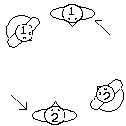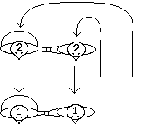
| Steps: | Piva (in 4), Saltarello (in 4), Ripresa (in 4), Movimento, Mezavolta, Voltatonda, Reverenza. | 
|
| Start: | Couple 1 is four steps ahead of Couple 2; partners are holding hands, the Women on the right, everyone facing up the hall. |
 | ||
| [Two-bar introduction on accompanying tape.] | ||
| 1-2 (three times) | \ 7 Saltarelli, starting Left. Drop hands. | |
| 3 | / | |
| 4 | Saltarello Right, spreading out and forming a square. Man 1 goes to the right, in front of Woman 1, and turns to face in, Woman 1 goes to the left and turns around, Man 2 goes forward to the left and Woman 2 goes forward to the right. (The dancers are now in a diamond shape which is about 3 steps on each side. Men are facing each other across one diagonal, Women across the other.) | |

| ||
| 5 | Men Movimento, then Women Movimento. | |
| 6-7 | Men Saltarello Left, Saltarello Right ending with Mezavolta Right, switching places, passing right shoulders. | |
| 5 (2nd time) | Women Movimento, then Men Movimento. | |
| 6-7 (2nd time) | Women switch places, as Men did.
(Everyone is again facing the other person of the same gender, across the diamond, but each dancer is now opposite the position held at the beginning of Section II.) | |
| 8 | Men Movimento, then Women Movimento. | |
| 9 | Men Voltatonda (4 Steps, starting on the Left, counterclockwise). | |
| 8 (2nd time) | Women Movimento, then Men Movimento. | |
| 9 (2nd time) | Women Voltatonda (4 Steps, starting on the Left, counterclockwise). | |

| ||
| 10-11 | Men do 4 Pive (2 per bar), starting on the Left, each going behind his partner and into the other man's place, moving counterclockwise halfway around the outside of the diamond. | |
| 10-11 (2nd time) | Women do the same, each also going behind her partner, so also moving counterclockwise. (All dancers are now in the positions they occupied at the beginning of Section II.) | |
| 12 | Men Movimento, then Women Movimento. | 13 | Men Movimento, then Women Movimento, again. |
| 14 | Men Ripresa Right. Partners take hands. (Couple 1 and Couple 2 are now somewhat to the left of each other.) | |
| 15 | Reverenza Left. | |
| Repeat the dance, Couple 1 still leading, but Women do everything first. The differences are: | 
| |
| Section I: Couple 1 starts off directly forward, as Couple 2 wheels around to join in behind them.
Section IV: The dancers move clockwise around the outside of the square, rather than counterclockwise. Bar 14: Women do a Ripresa to the Left to join their partners. Bar 15: Reverenza is on the Right. | ||
Recordings
Dances Courts 2 - One-note introduction. Section V is only three bars long, so drop the reverenza of Bar 15. Dance is played twice.
Danzare - Drum beats for introduction. Section V is only three bars long, so drop the reverenza of Bar 15. Dance is played twice.
Forse - Two-bar introduction. Works. Section V is only three bars long, so drop the reverenza of Bar 15. Dance is played twice.
Mesura - Four-bar introduction. Works. Section V is only three bars long, so drop the reverenza of Bar 15. Dance is played twice.
Music Richard - Four-beat introduction. Quite slow and very lyrical, but the sections are sometimes hard to parse, as the boundaries are not clear, especially when the repeat starts. Section V is only three bars long, so drop the reverenza of Bar 15. Dance is played twice.
Rose&Nefr - Four-beat introduction. Very slow. Works with this reconstruction. Played once.
Sonare - Two-bar introduction. Section V is only three bars long, so drop the reverenza of Bar 15. Dance is played twice.

Bar 4 |
Dance Notes
Formation of dance: Most of the dance is spent in an inward-facing square formation, but it is unclear if the dancers alternate genders around the square, as was chosen for this reconstruction, or if both men are on one side, and women on the other. Borrowing from contra-dance terminology, the former position will be referred to as improper, while the latter, shown here, will be called proper.
Both of these positions can be defended, and the choice results in slight variations in the dance. The most notable difference is in Section IV, where, if a proper formation is chosen, the direction taken by the two men, instead of both being counterclockwise, will be different from each other as is shown in the following figure.

|
However, the sources instruct the men to move to the right behind their partners for this figure, while in a proper formation, one of the men has to move left. The same problem occurs at the end of the dance, where the men are to perform a ripresa right to their partners; if the dancers are in a proper formation, one of the men will again have to move left, instead. Based on this evidence we decided on the improper formation.
A dance that is similar to Anello, but which has the proper formation, is Legiadra.
Starting position: The only source that indicates a starting position is PnD, where the two couples are only said to be four steps apart. Theoretically, the couples could be side by side, but one behind the other is more common, and the dancers are instructed to remain in a square thereafter (e.g. PnA "Rimangano In quadro"), so presumably are when they start.
Bar 9: PnD says this voltatonda is done with a doppio, as does NYp, while the other sources do not specify a particular step. Although an actual doppio can be used, we presumed that a four-step voltatonda is equivalent, and used it as easier. (See Volta in Piva, in the Voltatonda Section of the Steps Chapter.)
Bar 15: No step is given for this bar in PnD, but the music has it. The reverenza is taken from Sc and MOe, which differ quite a bit from PnD, but are the only sources that have a step for a fourth bar.
Repeat: As is usual, only NYp, Fn and Fl mention a repeat. That PnD doesn't may or may not have any bearing on whether a repeat was actually customary. However, because there is no mention that the second couple should lead if the dance is repeated, we presumed that the first couple would still do so. In this reconstruction we decided to have a repeat, with women doing the figures first, but still on the right side, in order to show how such a repeat would work. No repeat, a repeat where the men do everything first again, and one where the woman lead from the left side are also possible.
Music Notes

We have made no changes to the music. That said, there is one area where the intent is not entirely clear.
There seems to be disagreement among transcribers about the proper placement of the sequences beginning with sixteenth notes (the second and final sections of the music). A. William Smith treats the pairs of sixteenth notes as pickups, with the bar beginning on the eighth note. In the second section of the music this is merely a notational issue, as he ends the section with a shortened measure to compensate, but in the last section the difference is a little more pronounced. In addition, there is another minor change, the rhythm of the final pair of eighth notes, which Smith attributes to the manuscript, we believe incorrectly.
One difference in this section calls for special mention. In the excerpts below, Smith and Marrocco both transcribe the notes marked with asterisks as two eighth notes. We transcribed these notes as sixteenth notes because our copy of this manuscript shows the second of these notes clearly to be colored and the first one to be ambiguous. Perhaps our copy, which is farther removed from the original than those Smith and Marrocco were working with, is to blame.
Smith's transcription of the last section, our transcription of this same section, and the entire piece of music from the manuscript follow.
Smith:

Ours:

